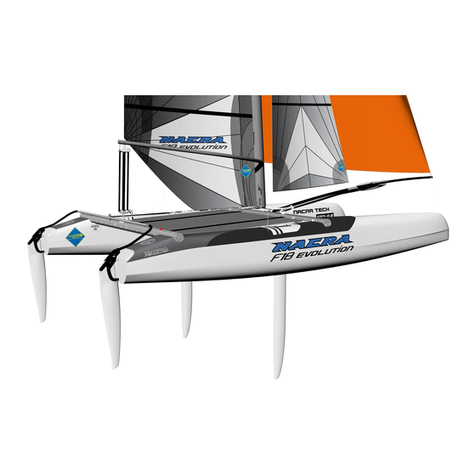3
1.8.1. Spinnaker sheet________________________________________________________________________________ 35
1.8.2. Spinnaker retrieve block_________________________________________________________________________ 35
1.8.3. Tack release line and tack line ____________________________________________________________________ 36
1.8.4. Jib sheet _____________________________________________________________________________________ 37
1.8.5. Mast rotation__________________________________________________________________________________ 38
1.8.6. Righting line __________________________________________________________________________________ 39
1.8.7. Mainsheet ____________________________________________________________________________________ 40
1.8.8. Mainsail traveler_______________________________________________________________________________ 42
2. Part 2. Rigging ________________________________________________________________________________________ 43
2.1. Raising the mast ___________________________________________________________________________________ 43
2.1.1. Preparing ____________________________________________________________________________________ 43
2.1.2. Fixing the stays and trapeze wires _________________________________________________________________ 44
2.1.3. Spinnaker halyard______________________________________________________________________________ 45
2.1.4. Raising the mast _______________________________________________________________________________ 46
2.1.5. Lowering the mast______________________________________________________________________________ 49
2.2. Rigging the boat ___________________________________________________________________________________ 50
2.2.1. Spinnaker pole ________________________________________________________________________________ 50
2.2.2. Jib sheet _____________________________________________________________________________________ 52
2.2.3. Tack line _____________________________________________________________________________________ 53
2.2.4. Jib traveler.___________________________________________________________________________________ 53
2.2.5. Cunningham __________________________________________________________________________________ 53
2.2.6. Boom________________________________________________________________________________________ 54
2.2.7. Mast rotation__________________________________________________________________________________ 54
2.2.8. Spinnaker halyard______________________________________________________________________________ 55
2.3. Fixing the sails ____________________________________________________________________________________ 57
2.3.1. Spinaker _____________________________________________________________________________________ 57
2.3.2. Raising the jib_________________________________________________________________________________ 58
2.3.3. Lowering the jib _______________________________________________________________________________ 60
2.3.4. Mainsail battens _______________________________________________________________________________ 61
2.3.5. Raising the mainsail ____________________________________________________________________________ 62
2.3.6. Lowering the mainsail __________________________________________________________________________ 63
2.3.7. Mainsail cunningham ___________________________________________________________________________ 65

































